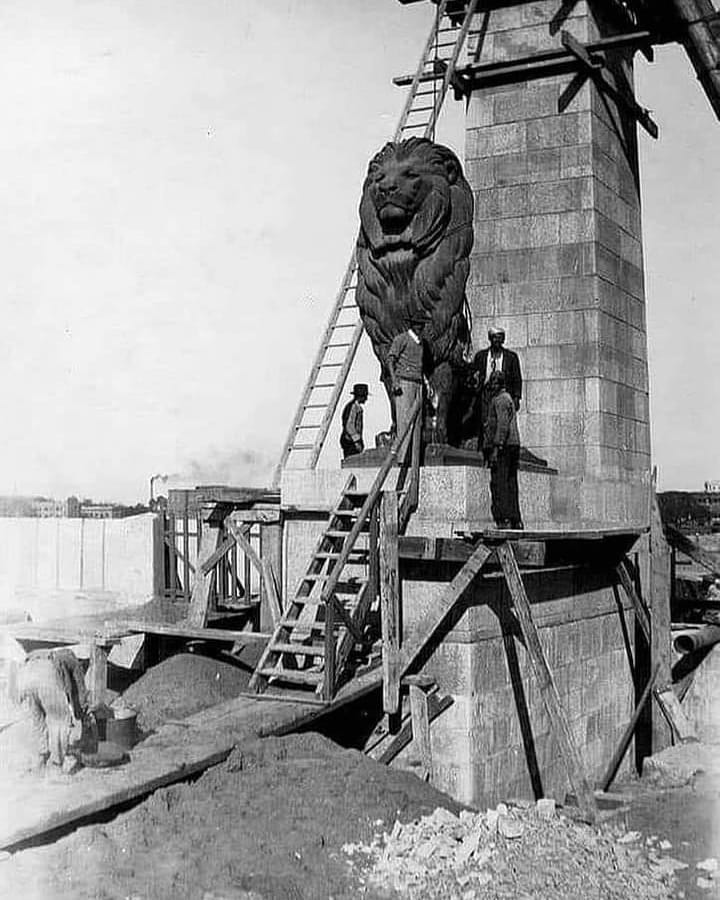CAIRO - 29 October 2024: Restoration works of the iconic Qasr el-Nil lions were recently carried out, causing a wave of anger and controversy among people and artists on social media, after photos of the lions appearing in a shiny black color, in what many reported as traditional painting of the statutes.
However, the Supreme Council of Antiquities issued a statement Tuesday confirming that the cleaning work that was carried out to the lions "was limited to removing dust and dirt and placing a transparent insulating layer to protect the statues from weather factors..... and no varnish or any colored or polished materials were used at all."
In response to what was circulated on social media, the council confirmed that "it is completely false, calling users to verify accuracy before publishing false news that may cause confusion," adding that the cleaning and maintenance work that the Council is currently carrying out comes within the framework of cooperation with the Cairo Governorate.
Earlier, the Head of the Islamic, Coptic and Jewish Antiquities Sector at the Supreme Council of Antiquities Dr. Gamal Mustafa contacted the Head of the Fine Artists Syndicate Tarek El-Komi over the incident, in order to hear the latter's opinion regarding the restoration works of the Qasr El Nil Lions.
Dr. Mustafa said that the Central Administration for Precise Restoration in the Projects Sector at the Supreme Council of Antiquities confirmed that "the cleaning and restoration operations are carried out accurately, and the process of washing the statues is done using treated and neutral soap to suit the bronze material from which the statues are made."
He added that the Cairo Governorate has sought the assistance of the Ministry of Tourism and Antiquities to cooperate in the cleaning and restoration operations of the Qasr El Nil Lions, which have not been cleaned for a long time and have suffered from significant deterioration.
According to Gamal, no rust residues were detected during the maintainance work due to the fact that these statues have been subjected to periodic cleaning work at close intervals since 2021. He explained that the lions were isolated each time, and maintained using the same precise scientific method and techniques.
Historical value of the lions
Although the Qasr el-Nil bridge lions are not registered as antiquities, according to Dr. Mustafa, but they carry historical importance. He ensured that the details of his meeting with the official will be announced on Wednesday, and that a technical committee is formed to study the materials being used in the restoration works.
On June 6, 1933, King Fouad inaugurated the Khedive Ismail Bridge, which is known today as Qasr al-Nil Bridge. It is the first bridge built over the Cairo Nile in 1869, and the second bridge built in Egypt in general after the Banha Bridge in 1856. It embodies Khedive Ismail's dream of turning Cairo into a piece of Europe.
Four lions were placed at the bridge entrances, two on each entrance. They were specially made of pure bronze in France and transported to Cairo.
Great artistic value
On Monday, the Syndicate of Fine Artists expressed its fear of the maintenance work of the lions of Qasr El Nil as part of a plan to maintain 21 statues in public squares in Cairo, announced by the Cairo Governorate and the Ministry of Tourism and Antiquities.
A statement by the Syndicate of Fine Artists said, on Monday evening, that maintenance work had begun on painting the lions of Qasr El Nil Bridge, in which it was observed that a "roller" was used to paint the bronze statues, which is a major mistake and a violation of the scientific and technical rules of maintenance work.
The syndicate's statement added that this "has caused the statues to lose their artistic value and obliterated the original color of the bronze material for works of great artistic and historical value."
"Their maintenance should not done using traditional methods, but rather by using more precise methods to remove the adhering dust only without using polishing materials that spoils the work on the visual and technical levels," the statement continued.


Comments
Leave a Comment